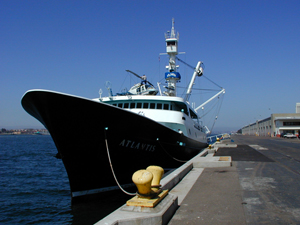Voices From the Waterfront
Meet Michael McGowan, tuna industry advocate

Michael McGowan stands on the San Diego waterfront where he began his career tuna fishing in the 1970s.
(Courtesy of Michael McGowan)
This month’s “Voices From the Waterfront” features Michael McGowan, of San Diego, who started fishing tuna as a captain of a high seas vessel in 1974 and worked his way up to be part-owner of 12 tuna fishing vessels and vice president for resourcing and government affairs at Bumble Bee Foods.
McGowan, others in the fishing industry, NOAA and representatives from 50 nations that fish for tuna are meeting this week in La Jolla, Calif., for Kobe III, an international conference to discuss ways to improve the sustainable management of the world’s tunas.
_______________________________
How did you get involved in tuna fishing?
In 1974, I was living in Laguna Beach and had just sold my sailboat business when friends suggested I talk to the owner of the largest tuna fishing boat in San Diego. I had a shipmaster’s license that I’d picked up after my time in the Navy in the Vietnam War. I was hired and the next day I was on an airplane headed to Abidjan, Ivory Coast, to pick up a boat and head out tuna fishing.
The F/V Atlantis was the last large purse seine vessel, called a superseiner, to fish tuna out of San Diego and unload at a San Pedro cannery, ending the era where San Diego/San Pedro were considered tuna capitals of the world.
Download here. (Photo: NOAA)
What was it like to work on a high seas tuna vessel?
It doesn’t matter if you’re off the coast of Africa or in the eastern Pacific, when the fishing is good it’s very exciting. I was the navigator, and the fishing captain was at the top of the mast. I’d be controlling the vessel as we encircled the tunas with a purse seine net. Then we’d pull in the cable that draws the net closed at the bottom and haul in the fish.
How has commercial tuna fishing changed in the years you’ve been involved?
When I first started, there were 120 large U.S. purse seine tuna vessels working out of San Diego and San Pedro, Calif. Today there are none. There are about 37 tuna fishing vessels that carry U.S. flags and are U.S. owned. They fish in the western Pacific Ocean. The issue of catching tuna without harming dolphins that naturally swim with tuna had a major effect on the American tuna industry, beginning in the late 1970s and early 1980s. Fishermen were concerned about this problem and helped devise ways to allow the dolphins to get out of the nets and not be killed. But in the process, by the early 1990s most of the U.S. tuna fleet had moved to the western Pacific Ocean where tuna and dolphins do not swim together in the same way, and there is no dolphin bycatch issue.
Albacore is one of several important tunas that are fished for global markets.
Download here. (Photo: NOAA)
What are the most significant challenges facing the commercial tuna fishing industry today?
A major issue is the long-term sustainability of tuna itself, so there will be tuna for generations to come. Tuna is a highly migratory species found in all the world’s oceans, so it’s managed internationally by regional fishery management organizations (RFMOs). It’s a continual challenge to get nations to come together and come up with meaningful conservation measures that follow the science and that are truly enforceable.
What’s your favorite fish?
I hate to say it, but it’s bluefin tuna. I like it because it has a very high oil content. I eat it as sashimi, but also barbecued.
Posted July 11, 2011 ![]()







